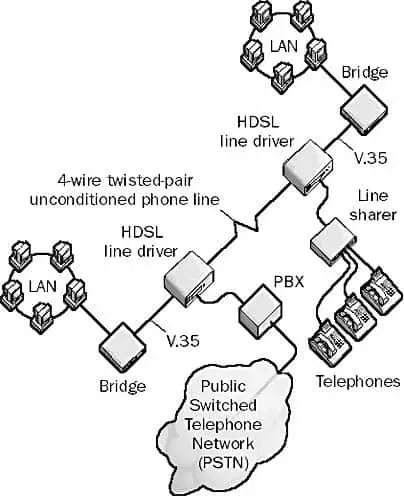HDSL, or High-bit-rate Digital Subscriber Line, is a modulation technology similar to Asymmetric Digital Subscriber Line (ADSL) that uses a group of existing copper twisted-pair subscriber telephone lines to transmit data at T1 or E1 speeds.
What is HDSL (High-bit-rate Digital Subscriber Line)?
HDSL is a modulation technology similar to Asymmetric Digital Subscriber Line (ADSL) that uses a group of existing copper twisted-pair subscriber telephone lines to transmit data at T1 or E1 speeds.
High-bit-rate Digital Subscriber Line (HDSL) was the earliest version of Digital Subscriber Line (DSL) to be widely implemented; it is often used as a low-cost alternative to dedicated T1 links for wide area networks (WANs) and for building-to-building communication in a campuswide network.
How HDSL Works?
HDSL was designed as an alternative to T-carrier services such as T1 lines. HDSL essentially operates in the same way as ADSL except that it is always symmetrical – that is, its upstream and downstream speeds are the same. This generally means that the maximum bandwidth for HDSL transmissions is less than for ADSL. HDSL comes in various formats, including the following:
- 668-Kbps full-duplex transmission over a single unconditioned, unshielded copper twisted-pair phone line.
- 1.544-Mbps full-duplex transmission (T1 speed) over unconditioned, unshielded twisted-pair cables. This is the most common configuration and is called Dual-Duplex HDSL. It uses twisted-pair phone lines with two pairs of wires (four wires) within the line, with full-duplex 784-Kbps transmission taking place over each pair of wires.
- 2.048-Mbps full-duplex transmission (E1 speed) over three unconditioned twisted-pair lines.
HDSL can carry both voice and data over a single communication link. The maximum distance for HDSL transmission is generally 3700 meters when running over unconditioned copper twisted-pair wiring; some vendors claim that their devices support twice this distance. This maximum distance from the telco’s central office (CO) is sometimes called the Carrier Service Area (CSA). HDSL is typically used for connecting bridges, routers, and telephone equipment such as Private Branch Exchanges (PBXs) over a campus using HDSL line drivers with built-in CSU/DSU (Channel Service Unit/Data Service Unit) functionality. It can also be used for private data networks, connections between points of presence (POPs), and other services. It is not widely implemented at the customer premises level, which uses the more popular ADSL or G.Lite for providing customers with high-speed Internet access.

TIP
You can use HDSL to connect campus networks and phone equipment at T1 speeds without the need for costly fiber-optic cabling. HDSL line drivers or line terminals generally support a variety of data interfaces, including V.35, G.703, and 10BaseT connections. They are configurable for N x 64 Kbps transmission speeds and sometimes include bridge or router functionality for framing of High-level Data Link Control (HDLC), Point-to-Point Protocol (PPP), Internet Protocol (IP), and other protocols. They can be used for LAN-LAN connections and for connecting local area networks (LANs) to frame relay networks or the Internet.
HDSL is easier to maintain and provision than conventional T-carrier span designs because HDSL requires a repeater only at both ends of the line, not every 1800 meters (6000 feet), as required by conventional T1 lines.